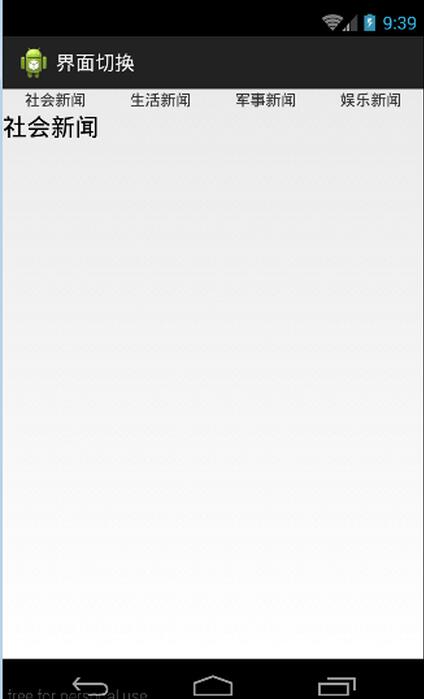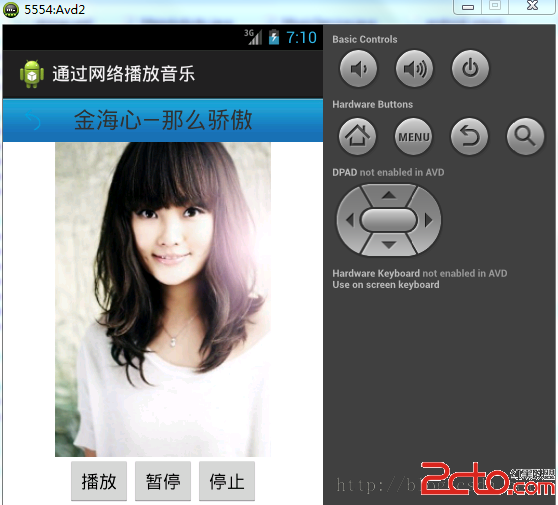編輯:關於Android編程
本文結合之前的動態創建fragment來進行一個實踐,來實現用Fragment創建一個選項卡
項目布局
<LinearLayout xmlns:android="http://schemas.android.com/apk/res/android" xmlns:tools="http://schemas.android.com/tools" android:layout_width="match_parent" android:layout_height="match_parent" android:orientation="vertical" tools:context=".MainActivity" > <LinearLayout android:layout_width="fill_parent" android:layout_height="wrap_content" android:orientation="horizontal" > <TextView android:id="@+id/tab1" android:layout_width="0dip" android:layout_height="wrap_content" android:layout_weight="1" android:gravity="center" android:text="社會新聞" /> <TextView android:id="@+id/tab2" android:layout_width="0dip" android:layout_height="wrap_content" android:layout_weight="1" android:gravity="center" android:text="生活新聞" /> <TextView android:id="@+id/tab3" android:layout_width="0dip" android:layout_height="wrap_content" android:layout_weight="1" android:gravity="center" android:text="軍事新聞" /> <TextView android:id="@+id/tab4" android:layout_width="0dip" android:layout_height="wrap_content" android:layout_weight="1" android:gravity="center" android:text="娛樂新聞" /> </LinearLayout> <LinearLayout android:id="@+id/content" android:layout_width="fill_parent" android:layout_height="fill_parent" > </LinearLayout> </LinearLayout>
新建Fragment1.java~Fragment4.java,其中Fragment1.java中的代碼如下:
public class Fragment1 extends Fragment {
@Override
public View onCreateView(LayoutInflater inflater, ViewGroup container,
Bundle savedInstanceState) {
return inflater.inflate(R.layout.fragment1, null);
}
}
其他幾個文件的代碼類似
新建fragment1.xml~fragment4.xml,其中fragment1.xml中的代碼如下:
<?xml version="1.0" encoding="utf-8"?> <LinearLayout xmlns:android="http://schemas.android.com/apk/res/android" android:layout_width="match_parent" android:layout_height="match_parent" android:gravity="center" android:orientation="vertical" > <TextView android:id="@+id/textview1" android:layout_width="wrap_content" android:layout_height="wrap_content" android:text="社會新聞" android:textAppearance="?android:attr/textAppearanceLarge"/> </LinearLayout>
其他幾個文件的代碼類似
MainActivity.java中的代碼如下:
public class MainActivity extends Activity implements OnClickListener {
private LinearLayout content;
private TextView tv1, tv2, tv3, tv4;
private FragmentManager fm;
private FragmentTransaction ft;
@Override
protected void onCreate(Bundle savedInstanceState) {
super.onCreate(savedInstanceState);
setContentView(R.layout.activity_main);
content = (LinearLayout) findViewById(R.id.content);
tv1 = (TextView) findViewById(R.id.tab1);
tv2 = (TextView) findViewById(R.id.tab2);
tv3 = (TextView) findViewById(R.id.tab3);
tv4 = (TextView) findViewById(R.id.tab4);
tv1.setOnClickListener(this);
tv2.setOnClickListener(this);
tv3.setOnClickListener(this);
tv4.setOnClickListener(this);
fm = getFragmentManager();
ft = fm.beginTransaction();
ft.replace(R.id.content, new Fragment1()); // 默認情況下Fragment1
}
@Override
public void onClick(View v) {
ft = fm.beginTransaction();
switch (v.getId()) {
case R.id.tab1:
ft.replace(R.id.content, new Fragment1());
break;
case R.id.tab2:
ft.replace(R.id.content, new Fragment2());
break;
case R.id.tab3:
ft.replace(R.id.content, new Fragment3());
break;
case R.id.tab4:
ft.replace(R.id.content, new Fragment4());
break;
default:
break;
}
ft.commit();
}
}
運行項目後如下效果:

以上就是本文的全部內容,希望對大家的學習有所幫助,也希望大家多多支持本站。
/**
* Created by gerry.zhong on 2016/10/11.
*/
var gerry =
(function(){
//創建一個獨立的對象,注入所有的方法,包括你想拋出去和不想拋出去的
var tool = {
AAAA:function(){},
BBBB:function(){
console.log("我只想內部使用,不想給別人用");
}
};
/*
* 該對象承載所有需要拋出去的對象
* 1.該對象中的方法可以自己寫
* 2.該對象中的方法可以注入(例子中的tempObj.tool.AA)
* 3.該對象也可以選擇性拋出給使用者需要的方法,也可以隱藏(tool.BBBB)
* */
var tempObj ={
//reader為一些初始化需要的操作,有時候會有注冊事件等,或者一些預操作
reader:function(){
},
//注入所有的選擇器,方便選擇器變化,直接修改該對象中的選擇器,而不需要全局去更改
selector:{
mySelector:"#mySelector", //原密碼
},
//注入所有的接口地址,方便接口變化可以進行,快速變更,不需要全局找引用的對象
interface:{
loginUrl:"",
},
//注入page中所有的事件,統一管理,建議命名規范:事件_命名,例 click_login
registerEle:{
click_login:function(){
//注冊單擊事件
}
},
//注入所有ajax請求,頁面所有請求,將在這裡統一管理,建議命名規范:ajax_命名,例 ajax_login
/*
* 該請求中有2種方案,看需求使用
* 1.不公用一個請求方案
* 2.公用一個請求,但是回調處理不一樣
* */
ajaxRequest:{
//不公用一個請求方案
ajax_login:function(){
$.post("","",function(data){
tempObj.callback.call_login(data);
});
},
//會有多個業務公用這個請求
ajax_login_T:function(callback){
//所有接口地址從interface中獲取,callback中tempObj.callback中處理
$.post("","",callback);
},
},
//處理所有回調函數,針對一個請求,處理一個回調
callback:{
//不共用請求處理回調
call_login:function(data){
//處理回調
},
//公用請求處理回調
call_login_T:function(){
var temp = function(){
};
tempObj.ajaxRequest.ajax_login_T(temp);
}
},
//所有使用的工具類,如果每個項目都單獨的unit.js或者common.js等存放一些公共方法的,這裡可以不使用
// PS:這裡存放的只是僅針對於這個頁面處理的一些tool,一般沒必要拋出去,不過看業務而定
tool:{
A:function(){
console.log("我是自己寫的方法");
},
AA:tool.AAAA, //這是我想拋出去給別人用的東西
},
//臨時緩存存放區域,僅針對本頁面,如果跨頁面請存放cookie或者localstorage等
//主要解決有時候會使用頁面控件display來緩存當前頁面的一些數據
temp:{
},
/*
* 業務使用區域,針對每個特別的業務去串上面所有的一個個原子
* 因為上面所有的方法,只是做一件事,這邊可以根據業務進行串服務,很簡單的
* */
firm:{
}
};
/*
* 閉包拋出去的方法
* */
var outputObj =function(){
//首先執行reader方法,初始化一些操作,比如注冊事件啥啥啥的
tempObj.reader();
/*
* 拋出給別人使用的對象
* 想給別人看和使用的東西,可以注入tempObj對象,就像tool中的AA的方式
* 不想給別人看和使用的東西,就像內部tool對象中的BBBB方法,你內部可以使用,外部是無法引用的
* */
return tempObj;
}
//拋出你希望拋出去的對象,因為你掌控了所有,哈哈。
return new outputObj();
})();
 Android之通過網絡播放一首簡單的音樂
Android之通過網絡播放一首簡單的音樂
首先,附上程序運行後的效果,如下圖所示: 一.部署一個web項目到tomcat服務器上:1.這個小程序是結合網絡來播放一首音樂的,首先,把我們搞好的
 Android Demo之旅 Activity、Service、BroadCast實現計數統計
Android Demo之旅 Activity、Service、BroadCast實現計數統計
時間匆匆,轉眼就是大半個月過去了,學習android的道理上艱苦而漫長呀!!自己寫了很多的小demo,總結總結,也在博客裡面留點足跡吧! 源代碼下載:htt
 打造Android 最實用的ViewPager 指示器控件
打造Android 最實用的ViewPager 指示器控件
為什麼我說它是最實用的 ViewPager 指示器控件呢? 它有以下幾個特點: 1、通過自定義 View 來實現,代碼簡單易懂; 2、使用起來非常方便; 3、通用性高,大
 Android App卡頓慢優化之多線程優化
Android App卡頓慢優化之多線程優化
本博客涉及的內容有:多線程並發的性能問題,介紹了AsyncTask,HandlerThread,IntentService與ThreadPool分別適合的使用場景以及各自